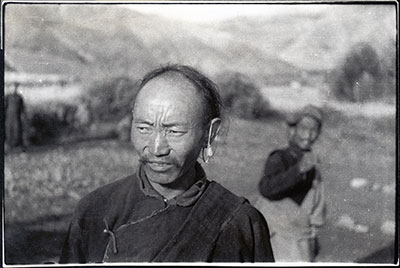
1998.131.193 (Print black & white)


1998.131.193 (Print black & white)

Frederick Spencer Chapman
Frederick Spencer Chapman
August 21st 1936
Tsangpo Valley Region > Singma Kangchung
1998.131.193
80 x 120 mm
Print gelatin silver
Donated 1994
Faith Spencer Chapman
Crop marks
British Diplomatic Mission to Lhasa 1936-37
Frederick Spencer Chapman
CP.36 [view film roll]
SC.T.2.193
'Lhasa the Holy City', F. Spencer Chapman, London: Chatto and Windus, 1940 [view list of illustrations]
Notes on print/mount - 'Village headman' has been written on the back of the print in pencil. The back of the print is covered with crop and proof marks and piece of paper for transferring these annotations to the front of the print has also been attached, but not annotated. Extensive cropping of the print image is suggested, which would centre the headman as the main referent and cut the two out of focus images in the background from the frame. The number '34 b' has also been written in the top left hand corner of the back of the print. The reference number 'C.P.36' has been written in pencil across the back of the print. This relates to the numbering system for images that Chapman adopted whilst on the Mission to Lhasa in 1936-37. [MS 17/1/2005]
Manual Catalogues - Caption in Chapman's hand-written list of negatives made whilst on the Mission to Lhasa, 1936-7 [See PRM Manuscripts Collection]: 'Mule driver'; PRM Manuscripts Collection: ‘List of Tibetan Prints and Negatives’ - Book 4: ‘13/3 - Tibetan local headman’ [MS 12/03/2006]
Other Information - Related Images: Images prefixed with 'CP.' seem all to have been taken on or around the 21st August 1936 and comprise a group of negatives containing images of the route to Lhasa including rock paintings, a ‘ghost scarer’, environs of Nyapsu La, Singma, boats on the Tsangpo, birds and flowers. The list is referred to as ‘P’ in Chapman’s papers, but all the images were prefixed ‘CP’ in the draft album and related prints in the Pitt Rivers Museum collection are also annotated as ‘CP’ [MS 12/03/2006]
Other Information - The ear ornament is worn around the ear on a string because it is too heavy to wear suspended from a hole in the ear. The earring or Along is made of gold with a large piece of turquoise in the centre [TS 20/1/2005]
Other Information - Dress: Chapman comments on the earrings worn by non-aristocratic Tibetan men in Lhasa The Holy City [London: Chatto & Windus, 1938; ; reprint, London: Readers Union Ltd., 1940]. Writing of the attire of the muleteers who accompanied the Mission to Lhasa, Chapman stated: "The better dressed ones wore a large single ear-ring in the left ear and a plain piece of turquoise in the other. This ear-ring took the form of a fluted gold ring about two inches in diameter, with a turquoise mounted in the front. As this ring is very heavy, it is supported by a loop of red cotton over the top of the ear" [1940, p.13] [MS 12/3/2005]
For Citation use:
The Tibet Album.
"Tibetan man with ear ornament"
05 Dec. 2006. The Pitt Rivers Museum.
<http://tibet.prm.ox.ac.uk/photo_1998.131.193.html>.
For more information about photographic usage or to order prints, please visit the The Pitt Rivers Museum.
© The Pitt Rivers Museum